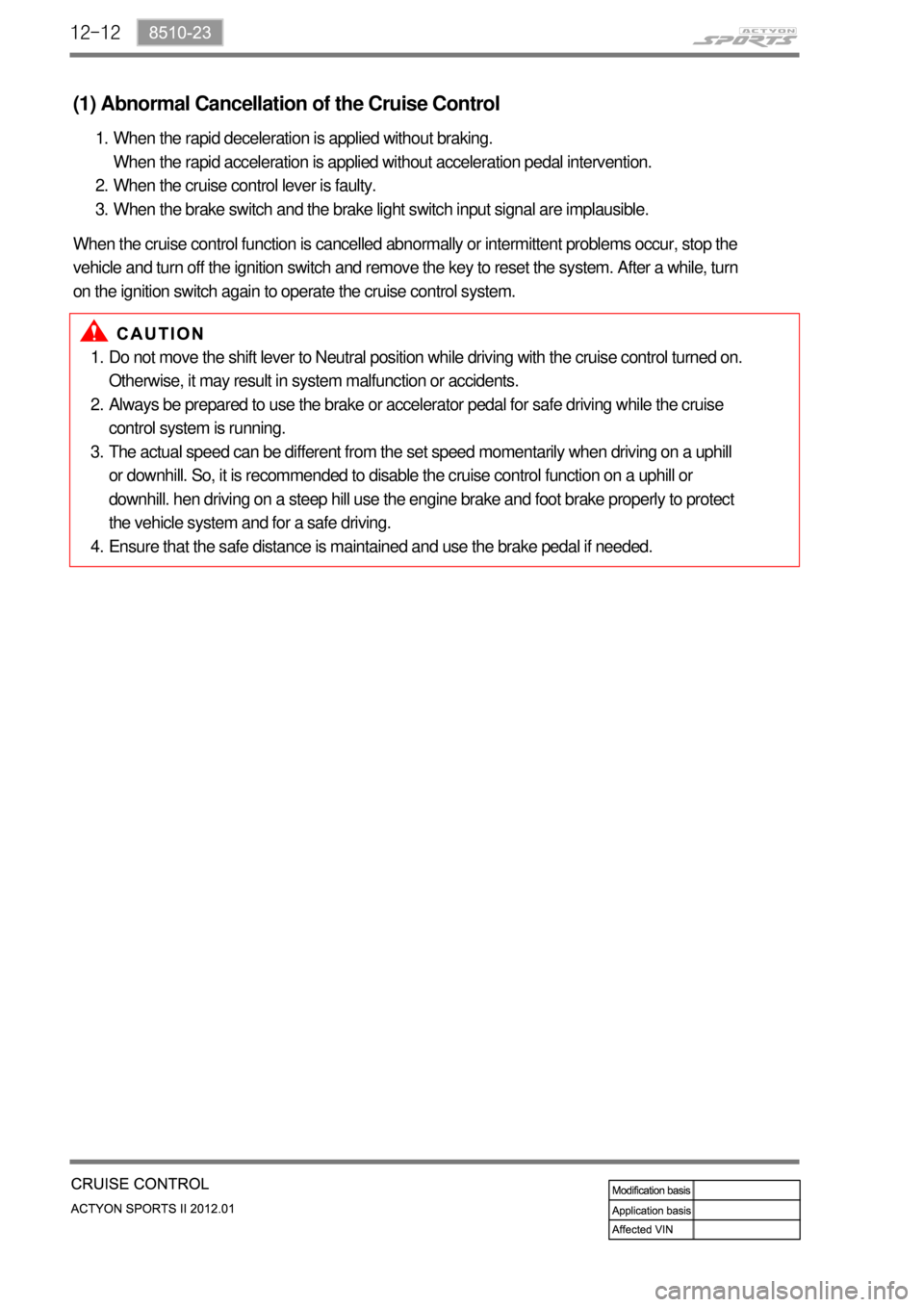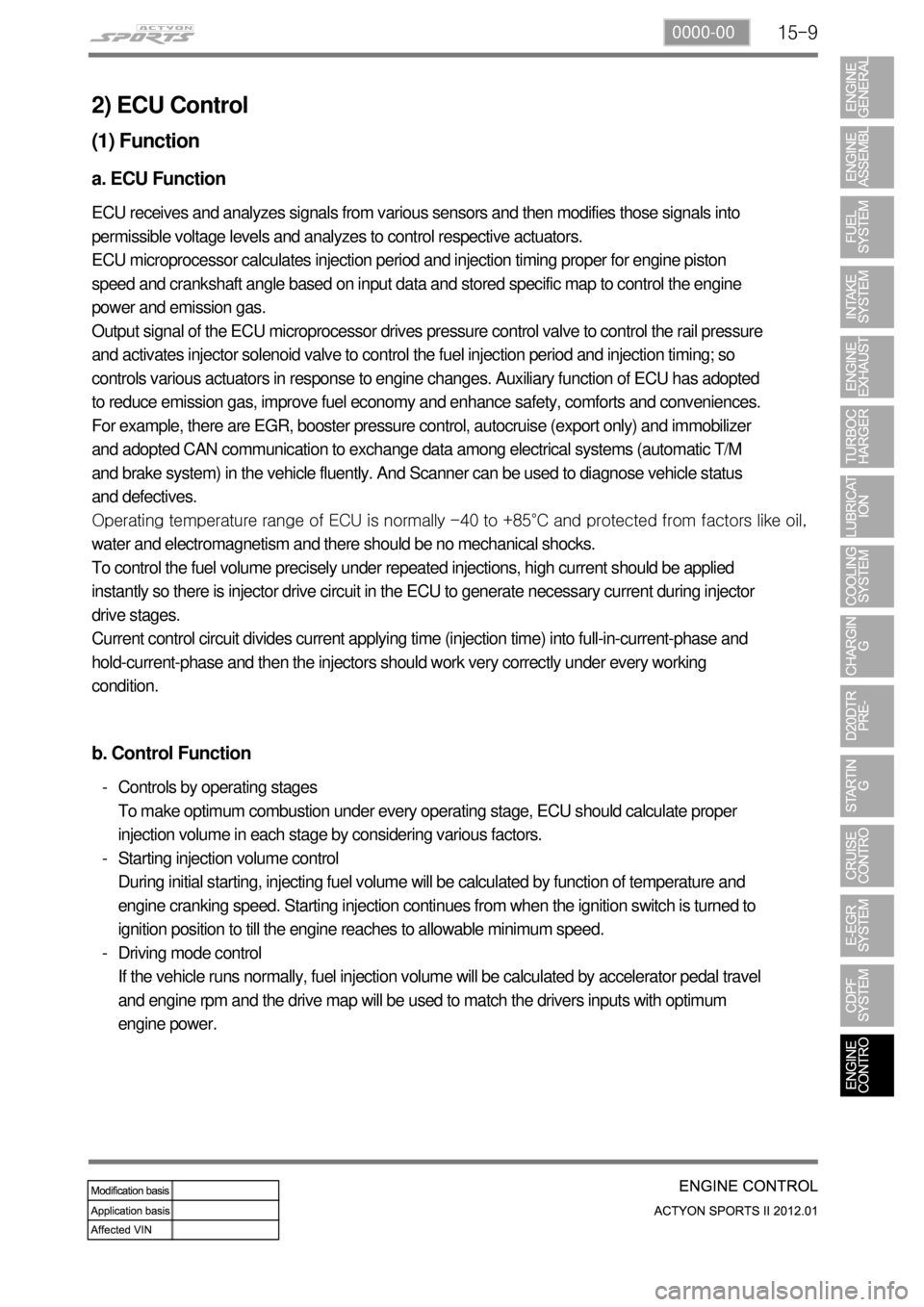Page 245 of 828
07-51543-00
1. SYSTEM DESCRIPTION
1) Overview
The lubrication system supplies oil to each lubrication section to prevent friction and wear and to
remove heat from the friction part. As the engine runs, frictional heat is generated on each
lubrication section. If this condition persists, the bearing can be burned and stuck.
In other words, it creates an oil film on each sliding surface to convert solid friction to liquid
friction in order to minimize wear and prevent temperature increasing on the friction part.
For the D20DTF engine with no oil pressure switch, the engine ECU receives the low engine oil
level signal from the oil level sensor and communicates with the instrument cluster through the
CAN communication to turn on the warning lamp.
2) Components
Oil coolerOil dipstick gaugeOil pump
Oil filter moduleOil pressure switchOil pan
Page 283 of 828

12-12
Do not move the shift lever to Neutral position while driving with the cruise control turned on.
Otherwise, it may result in system malfunction or accidents.
Always be prepared to use the brake or accelerator pedal for safe driving while the cruise
control system is running.
The actual speed can be different from the set speed momentarily when driving on a uphill
or downhill. So, it is recommended to disable the cruise control function on a uphill or
downhill. hen driving on a steep hill use the engine brake and foot brake properly to protect
the vehicle system and for a safe driving.
Ensure that the safe distance is maintained and use the brake pedal if needed. 1.
2.
3.
4.
(1) Abnormal Cancellation of the Cruise Control
When the rapid deceleration is applied without braking.
When the rapid acceleration is applied without acceleration pedal intervention.
When the cruise control lever is faulty.
When the brake switch and the brake light switch input signal are implausible. 1.
2.
3.
When the cruise control function is cancelled abnormally or intermittent problems occur, stop the
vehicle and turn off the ignition switch and remove the key to reset the system. After a while, turn
on the ignition switch again to operate the cruise control system.
Page 312 of 828

15-90000-00
2) ECU Control
(1) Function
a. ECU Function
ECU receives and analyzes signals from various sensors and then modifies those signals into
permissible voltage levels and analyzes to control respective actuators.
ECU microprocessor calculates injection period and injection timing proper for engine piston
speed and crankshaft angle based on input data and stored specific map to control the engine
power and emission gas.
Output signal of the ECU microprocessor drives pressure control valve to control the rail pressure
and activates injector solenoid valve to control the fuel injection period and injection timing; so
controls various actuators in response to engine changes. Auxiliary function of ECU has adopted
to reduce emission gas, improve fuel economy and enhance safety, comforts and conveniences.
For example, there are EGR, booster pressure control, autocruise (export only) and immobilizer
and adopted CAN communication to exchange data among electrical systems (automatic T/M
and brake system) in the vehicle fluently. And Scanner can be used to diagnose vehicle status
and defectives.
<00760097008c00990088009b00900095008e0047009b008c00940097008c00990088009b009c0099008c0047009900880095008e008c00470096008d0047006c006a007c00470090009a0047009500960099009400880093009300a000470054005b005700
47009b009600470052005f005c00b6006a004700880095008b> protected from factors like oil,
water and electromagnetism and there should be no mechanical shocks.
To control the fuel volume precisely under repeated injections, high current should be applied
instantly so there is injector drive circuit in the ECU to generate necessary current during injector
drive stages.
Current control circuit divides current applying time (injection time) into full-in-current-phase and
hold-current-phase and then the injectors should work very correctly under every working
condition.
b. Control Function
Controls by operating stages
To make optimum combustion under every operating stage, ECU should calculate proper
injection volume in each stage by considering various factors.
Starting injection volume control
During initial starting, injecting fuel volume will be calculated by function of temperature and
engine cranking speed. Starting injection continues from when the ignition switch is turned to
ignition position to till the engine reaches to allowable minimum speed.
Driving mode control
If the vehicle runs normally, fuel injection volume will be calculated by accelerator pedal travel
and engine rpm and the drive map will be used to match the drivers inputs with optimum
engine power. -
-
-
Page 384 of 828

04-8
The cooling fans are mounted behind the radiator in the engine compartment. The electric cooling
fans increase the flow of air across the radiator fins and across the condenser on air conditioned
(A/C)-equipped vehicles.
This helps to speed cooling when the vehicle is at idle or moving at low speeds.
All models have two fans. The main fan is 320 mm (12. 6 inches) in diameter with seven blades to
aid the airflow through the radiator and the condenser. An electric motor attached to the radiator
support drives the fan.
The auxiliary fan is 320 mm (12.6 inches) in diameter.
A/C Off or Non-AC Model ▶
The cooling fans are actuated by the engine control module (ECM) using a low-speed
cooling fan relay, a high-speed cooling fan relay and a cooling fan motor relay.
The ECM will turn the cooling fans on at low speed when the coolant temperature reaches
95°C(203°F) and at high speed when the coolant temperature reaches 105°C(221°F).
The ECM will change the cooling fans from high peed to low speed at 100°C(212°F) and
will turn the cooling fans off at 90°C (194°F). -
-
-
A/C On ▶
The ECM will turn the cooling fans on at low speed when the A/C system is on. The ECM
will change to high speed when the high side A/C pressure reaches 1860 kPa (269.8 psi).
The cooling fans will return to low speed when the high side A/C pressure reaches 1378
kPa (199.8 psi). -
-
7) Engine Coolant Temperature Sensor
The Engine Coolant Temperature (ECT) sensor uses a temperature to control the signal voltage to
the Engine Control Module (ECM).
8) Coolant Temperature Gauge
The coolant temperature gauge controls the instrument panel temperature indicator. The coolant
temperature gauge is located with ECT sensor.
Page 407 of 828

12-12
Do not move the shift lever to Neutral position while driving with the cruise control turned on.
Otherwise, it may result in system malfunction or accidents.
Always be prepared to use the brake or accelerator pedal for safe driving while the cruise
control system is running.
The actual speed can be different from the set speed momentarily when driving on a uphill
or downhill. So, it is recommended to disable the cruise control function on a uphill or
downhill. hen driving on a steep hill use the engine brake and foot brake properly to protect
the vehicle system and for a safe driving.
Ensure that the safe distance is maintained and use the brake pedal if needed. 1.
2.
3.
4.
(1) Abnormal Cancellation of the Cruise Control
When the rapid deceleration is applied without braking.
When the rapid acceleration is applied without acceleration pedal intervention.
When the cruise control lever is faulty.
When the brake switch and the brake light switch input signal are implausible. 1.
2.
3.
When the cruise control function is cancelled abnormally or intermittent problems occur, stop the
vehicle and turn off the ignition switch and remove the key to reset the system. After a while, turn
on the ignition switch again to operate the cruise control system.
Page 408 of 828
01-38410-02
ICM
Interior Fuse & Relay
Box (RH)
2. MOUNTING LOCATION
In engine compartment ▶
In vehicle ▶
Fuse & Relay Box In Engine
Compartment
1. OVERVIEW
The ICM (Integrated Control Module) mounted to the back of the STICS is integrated with the door
lock/unlock relay, windshield de-icer relay and turn signal lamp relay. There are four fuse & relay
units.
Interior Fuse & Relay
Box (LH)Mounting Location of ICM
Page 412 of 828
01-78410-02
5. OPERATING PROCESS OF ICM BOX
The following relays are integrated into the ICM (Integrated Control Module) box.
Door lock/unlock relay
Windshield de-icer relay
Turn signal lamp relay -
-
-
1) Overview
2) Mounting Location
Door lock/
unlock relay
Turn signal lamp relay
Windshield
de-icer relay
Inner view of ICM PCB
PAS buzzer
Chime
ICM box
STICS
The relays in the ICM box cannot be replaced respectively; so if the any of the
components on the PCB are defective, they should be replaced as an assembly.
Page 415 of 828
01-10
(3) Turn signal lamp (Hazard warning lamp operation)
The B+ power supplied through the No. F66 interior fuse on the right-hand of the engine
compartment is on standby on the No. 30 and 86 hazard warning lamp relay terminals via the ICM
No. 18 terminal.
The STICS activates and/or controls the hazard warning lamp relay using the No. A26 terminal
depending on the operating conditions. The activated relay supplies the No. 87 and 87a terminals
with the power, which is on standby on the No. 30 hazard warning lamp relay terminal.
The supplied power flows to the corresponding circuit via the No. 7 and 16 ICM terminals.